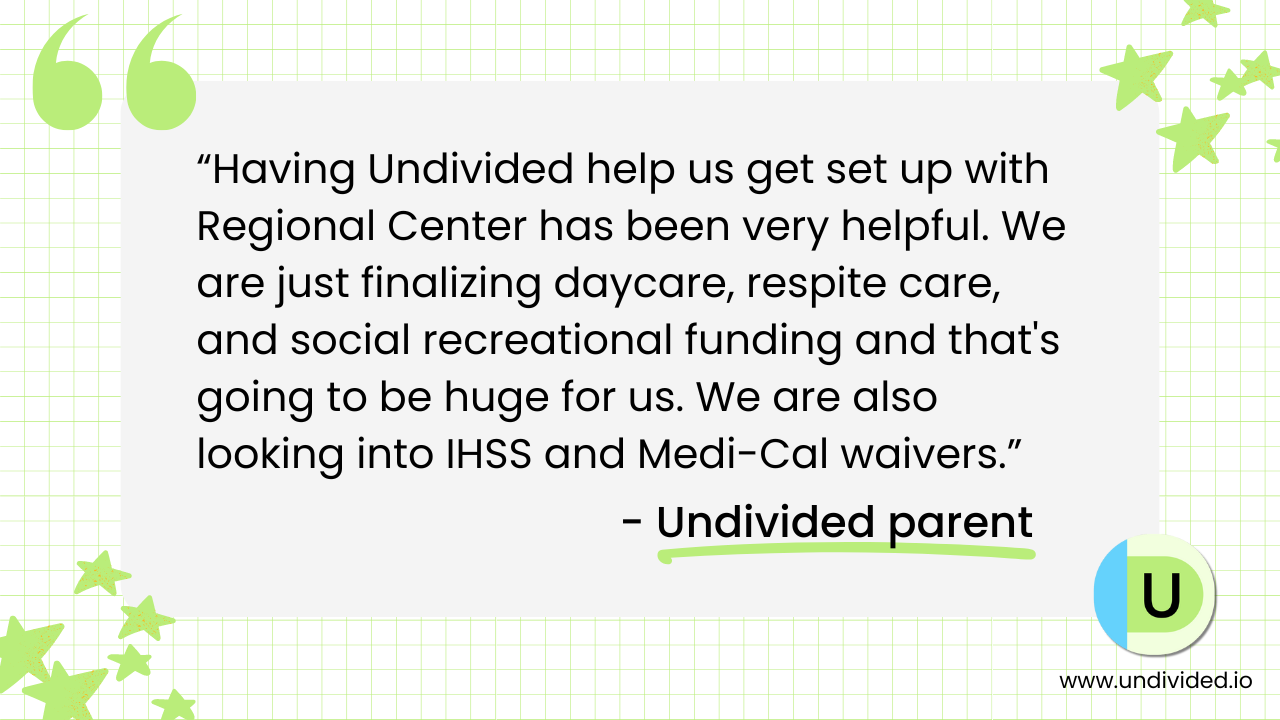
Figuring out how to pay for your child’s needs can be a stressful, overwhelming, and emotional process. And the layers of complexity increase when there are multiple funding sources and processes. Our experts—including Public Benefits Specialist Lisa Concoff Kronbeck and Director of Health Plan Advocacy Leslie Lobel—answer lots of financial questions during our member office hours. Today, Concoff Kronbeck and Lobel share 7 tips for getting your child’s needs funded across multiple funding sources such as Medi-Cal, private insurance, Regional Center, and California Children’s Services (CCS).
Gain access to Undivided’s comprehensive resources and receive our weekly newsletter.
1. Follow the funding order of operations
If your family is using multiple funding sources, there’s a specific order to follow. The general rule of thumb is that private insurance pays first and Regional Center pays last (aka the “payer of last resort”), with Medi-Cal and CCS in between. If a family has Medi-Cal and CCS, there is coordination between the two sources. CCS reviews the claim first, and if the claim involves something Medi-Cal will pay for, Medi-Cal will pay; if not, the claim goes back to CCS. In this scenario, the order of operations is: 1) private insurance, 2) CCS, 3) Medi-Cal, 4) going back to CCS, 5) Regional Center, though Concoff Kronbeck notes that there are exceptions in some counties given efforts to streamline the delivery of CCS and Medi-Cal.
2. Build a paper trail
Lobel advises parents to build a paper trail as you request funding from different sources. She notes, “Regional Center will require written proof of denial of all other pertinent funding sources before they’ll consider a funding request. So don’t even go to Regional Center until you have all your other written denials lined up like ducks in a row.”
3. Combined sources can help you get costs covered
There are different scenarios in which funding sources can cover expenses in combination. For example, Lobel notes that if you are seeking Applied Behavior Analysis (ABA) therapy with a provider that accepts your primary insurance and is also contracted with the specific type of Medi-Cal that you have, then the combination of those two funding sources can absolve you of payment. Concoff Kronbeck advises that for families with a referral for ABA, Regional Center is also an option in scenarios where a private insurance company will not cover ABA and the ABA company doesn’t contract with fee-for-service Medi-Cal.
Lobel notes another example of combinatory funding: If you’re seeking a major piece of equipment from a durable medical equipment provider, Medi-Cal or CCS and insurance together can meet your funding for medically necessary items. And again, sometimes Regional Center will fund those costs as the payer of last resort.
4. There are caps in combination
It’s important to note that Medi-Cal has a cap on its reimbursements. Concoff Kronbeck advises that, generally speaking, Medi-Cal will pay whatever private insurance doesn’t cover up to the Medi-Cal reimbursable rate. And there are scenarios—for example, hearing aids—where CCS can cover an expense. “The [Medi-Cal] cap generally is not going to cover the kind of complex pediatric hearing aids that young kids require,” said Concoff Kronbeck.

5. Focus on medical necessity, not convenience
When it comes to getting expenses covered, “it’s always going to be about medical necessity, not convenience,” says Concoff Kronbeck. For example, a cup holder attachment for a wheelchair will be considered a convenience. Another example: a car seat may be considered a safety item, but if the car seat is required in order to maintain correct posture for safe transport, it should be covered as a medical necessity.
6. Be prepared to advocate and appeal
Your funding journey will likely involve denials; be prepared to advocate and appeal. “Insurance companies and government benefits sources count on you being demure or going away or thinking you’re not entitled,” Lobel notes. “There’s an appeal process for a reason and you have a right to use it,” urges Concoff Kronbeck. Lobel adds that a small fraction of people mount appeals, with a high rate (around 50-60%) of appeals granted.
Before submitting an appeal, Lobel encourages families to ensure that they have a solid basis for an appeal based on the benefits and coverage documented in the funding source’s own terms. “Don’t appeal on medical necessity if it’s not a medical necessity issue. Read the reason you’re getting the denial and see exactly why it’s being denied and make sure your appeal is responsive to the actual reason why you’re being denied,” she advises.
7. Consider planning expenses across the year
If you have the ability to plan and wait, one option is to plan expenses across the year in line with your deductible. Lobel notes, “A savvy user could definitely plan what time of year they want to do certain things, bulk loading things to the beginning of the year. Or if you’re a family that doesn’t have Medi-Cal, you could bulk load something expensive towards the end of the year when you’ve met your deductible somewhere else.”
For more information and to dig into additional funding options, check out our popular guide, How Do We Pay For It All? Undivided’s Guide to Funding Resources. And consider an Undivided membership so you can get your burning questions answered during our member office hours.
Join the Undivided Community to get more resources like this in your inbox
100% free | Curated for you

A Navigator is your Partner at each turn
*Currently offering Navigator Kickstarts to residents of California



